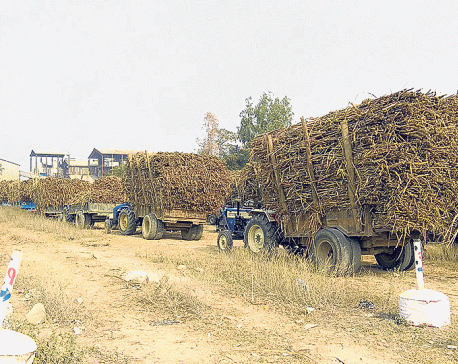
OR
Opinion
The King of Fertilizers
Published On: April 3, 2023 08:30 AM NPT By: Dr Dinesh Panday | @@dineshpanday


Dr Dinesh Panday
The author is a soil scientist specializing in carbon and nitrogen cycling in agroecosystems. He can be reached at agriculturenepal@gmail.com.agriculturenepal@gmail.com
More from Author
What do chemical fertilizer, feed supplement, pretzel, and lotion or cream for dry skin have in common? They all use urea, which was first discovered and isolated from human urine by H.M. Rouelle in 1773 and was then successfully synthesized from inorganic materials by F. Wohler in 1828. This discovery prompted Wohler to write triumphantly to Berzelius: "I must tell you that I can make urea without the use of kidneys, either man or dog. Ammonium cyanate is urea." One of the main compounds in human or animal urine is urea, a waste product in the metabolism of nitrogen (N)-containing substances such as proteins.
There are almost no farmers in the world who do not know urea as a fertilizer that they can apply in their agricultural fields, urea fits into most of the land types. Urea is one of the major sources of N-based fertilizer that is required for plants’ growth and development. Today, fertilizers are commonplace, however, farmers used to rely on manure, bones, and ash to supplement the soil without knowing their benefits 200 years ago.
When farmers were searching for better fertilizers, then seabird guano made its appearance in 1840. The term guano generally refers to deposits of excreta, carcasses, and eggshells of seabirds, which transform under certain climatic conditions into fertilizer. Farmers and chemists claimed that guano from Chincha Islands in Peru was the world’s finest fertilizer since it contained high concentrations of nitrogen, phosphate and potassium which increased agricultural production remarkably. However, this was not a long-term approach and Chincha Islands’ guano was gone within a few years due to extensive mining operations.
In 1843, two British scientists discovered that addition of N-fertilizers increased wheat yields. Nitrogen is the most abundant element (accounts for 78%) in Earth’s atmosphere. However, plants cannot directly convert atmospheric nitrogen to soluble N-compounds, so scientists had to search for a solution. The German scientist F. Haber discovered in 1909 that the chemical reaction of nitrogen and hydrogen produced ammonia (NH3) —the main component in N-based fertilizers. After five years, C. Bosch developed the first industrial-scale application of the Haber process, sometimes called the Haber–Bosch process; the greatest innovation of the 20th century. Haber’s and Bosch’s contributions to ammonia production were honored with two Nobel prizes— these advances have notably increased yields of food and feed grain crops in the world.
However, the Haber-Bosch process is energy and greenhouse gas intensive. Ammonia production using this process is estimated to comprise 2% of the world's total energy consumption, which is mainly based on natural gas or gas derived from coal. Today, primarily ammonia produced from industrial chemical reactions goes toward making fertilizer— many types of N-based fertilizers. For example, urea is directly synthesized from carbon dioxide and ammonia in industrial plants. This is important to understand why urea is known as the king of fertilizers and how it is being utilized in soil. Urea is the most popular fertilizer because it has the highest percent of N content (i.e., 46%) of solid fertilizers, which means less weight is required and so it is still comparatively cheaper to produce than other commercially available fertilizers and is easy to transport.
Urea contains four elements: carbon, hydrogen, oxygen, and nitrogen. The first three elements are known as structural nutrients for plants and nitrogen as one of the macronutrients. Macronutrients are known as essential nutrients, which are required in relatively large amounts for plant growth and development. Nitrogen is needed by plants to make protein and to make chlorophyll, the green pigment in plants used to trap light and make sugars to grow. Though urea is a source of nitrogen for plants, it cannot be absorbed directly. Irrespective of whether nutrients originate from organic or inorganic sources, plants are only capable of absorbing nutrients in particular forms. Nitrogen is only absorbed as nitrate or ammonium ions. Plants can get only ammonium form from urea fertilizer, other fertilizers such as urea ammonium nitrate provides both ammonium and nitrate. Urease is the enzyme produced by soil microorganisms, which converts urea into ammonium on contact with water in soil.
Urea can be applied to soil as a solid solution or for certain crops as a foliar spray. It can be utilized by plants rapidly— even after a few hours of application, up to two weeks in soil. This is a rapid rate of conversion compared to other nutrient sources, such as compost manure, which takes about 6-8 weeks or even more. Since urea is readily available to plants, if it is not applied in appropriate time, everything can be lost as well. Urea is very soluble in water, if the soil is wet or it has a high pH (>7) or high temperature (>21°C) during fertilizer application time, it can be easily lost as ammonia gas to the atmosphere. If it is followed by heavy rains or irrigation, the majority of nitrate ions can be moved by leaching into nearby streams, lakes, and rivers or lost by denitrification. So, when farmers are applying urea on soil surface, it is advised to follow on a cool day, in weather between 0-16°C and with little to no wind. Similarly, it is advised to till the soil to incorporate urea, or at least do not leave urea on the soil surface without any cover. There are other practices as well, such as use of urea fertilizer with urease inhibitors before planting, applying the required amount of urea as split doses, etc.
Our hunger for urea fertilizer is increasing every year. The global urea market reached a volume of 176 million metric tons (MMT) in 2022 and is estimated to reach 183 MMT in 2024.Global prices for fertilizer jumped by 80% last year due to surging prices of coal and natural gas. There are other factors as well, such as supply-chain disruptions brought on by the coronavirus pandemic, bad weather, years of insufficient investment in production capacity, and war in Ukraine. So rising prices could ultimately mean higher costs at the dinner table and increase hunger and malnutrition in low-income countries.
The demand for urea in Nepal is about 400,000 MT per year. Including urea, Nepalese farmers are using seven types of fertilizers. However, fertilizer shortage is a chronic problem. The country does not have its own fertilizer plant and the Government of Nepal hardly meets 1/3rd of fertilizer supply on time through imports.When fertilizers are not available at the right time, it is hard to imagine anything about the best nutrient management strategies for crop production. On the top of it, the Government of Nepal decided to cut the subsidy given to farmers for the purchase of chemical fertilizers on March 10, 2023. Fortunately, the government decided to continue subsidies on chemical fertilizers within 10-days after the announcement.The current price of urea is NPR 14 per kg, where the government bears NPR 112 per kg for import.
The trend of chemical fertilizers consumption in Nepal is completely dependent upon subsidies provided by the government, which was started in 1974. From 1999 to 2008, the use of fertilizers gradually declined due to removal of subsidies on price and transportation. Then it was reintroduced in 2009. Hence, it is very important to conduct an extensive study on this matter before taking any decisions. It is because the rising fertilizer prices and supply disruptions directly threatens agricultural production. When fertilizer prices surge, most farmers cannot afford it even if they are going to fetch a good price of produce in future. Without enough fertilizer, farmers cannot grow enough food.There are also ongoing discussions of establishing a chemical fertilizer plant, shifting into organic farming, and exploration of locally available nutrient sources, etc.
We cannot forget chemical fertilizers such as N-rich urea were the agricultural boom of the 1960s and 1970s, known as the Green Revolution. It introduced rice-wheat as a major cropping system in the Indo-Gangetic Plains by development of high-yielding plant varieties that are more responsive to fertilizers. However, those chemical fertilizers should not be taken as food for plants since it has many negative consequences as well. For example, soil acidity is a big problem in the eastern part of Nepal due to continuous application of acid forming N-based fertilizers rather than following a balanced dose of fertilizers, an advisory recommendation made from research. Likewise, a healthy diet is essential for good health and nutrition, plants need a balanced fertilizer program which can keep our soil alive.
You May Like This

Like every monsoon, farmers don't have fertilizers
BHAKTAPUR, June 24: Like in previous years, farmers in Bhaktapur will be facing dearth of chemical fertilizers this monsoon as well. Read More...

Digitalizing farming
Digitalizing farming process by providing farmers access to the internet can help solve most of the problems facing Nepali farmers, including... Read More...

Farmers forced to sell sugarcane on credit
Three sugar mills of Nawalpur and Parasi districts have started crushing sugarcane. However, farmers have not got payment for their... Read More...






Just In
- Govt should not look for enforcing populist budget for next FY: Former finance ministers
- DoFE requests relevant parties to provide essential facilities to foreign workers traveling abroad
- Foundation stone laid for building a school in Darchula with Indian financial assistance
- 151 projects to be showcased for FDI in Third Investment Summit
- Police disclose identity of seven individuals arrested with almost 2 kg gold and more than Rs 10 million in cash
- NIMSDAI Foundation collaborates with local govt for Lobuche Porter’s Accommodation Project
- Home Ministry directs recalling security personnel deployed for personal security against existing laws
- Fake Bhutanese refugee case: SC orders continued pre-trial detention for seven individuals including former DPM Rayamajhi













Leave A Comment